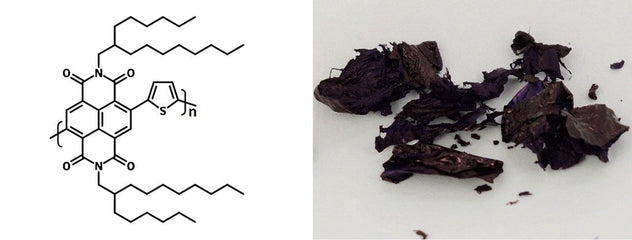PNDI(2HD)T
CAS Number 1675973-74-6
Luminosyn™ Polymers, Materials, OFET & OLED Polymer Materials, OPV Polymers,PNDI(2HD)T, polymer acceptor for high performance all-PSCs
High quality polymer available for fast, secure dispatch
Specifications | MSDS | Literature and Reviews | Technical Support
PNDI(2HD)T, CAS number 1675973-74-6, also known as P(NDI2HD-T), is a copolymer used as a polymer acceptor in high-performance all-polymer solar cells (All-PSCs).
All-PSCs based on PBDTTTPD and PNDI(2HD)T exhibited a PCE of 6.64% with better flexibility, stretching, and bending properties when compared to polymer solar cells with PCBMs as acceptors. The high performances of these devices with P(NDI2HD-T) as polymer acceptor was due to the high open circuit voltage (1.06 V) and favorable interfacial interactions between the active layers of polymer donor and acceptor.
It has also been demonstrated that a combination of polymer and small molecule acceptors, such as P(NDI2HD-T)/ITIC with only a small amount of ITIC in presence, significantly improves the device PCE from 6% to over 7% when PTP8 was used as polymer donor [5].
The Luminosyn™ Range
General Information
| Full name | Poly{[N,N'-bis(2-hexylldecyl)naphthalene-1,4,5,8-bis(dicarboximide)-2,6-diyl]-alt-2,5-thiophene} |
| Synonyms |
|
| Chemical formula | (C50H70N2O4S)n |
| CAS number | 1675973-74-6 |
| HOMO / LUMO | HOMO = -5.64 eV, LUMO = -3.79 eV [1] |
| Classification / Family | PNDI polymers, Organic n-type semiconducting materials, Organic photovoltaics, All-polymer solar cells (All-PSCs), Electron-acceptor polymers, OPV acceptors, OFETs, Perovskite solar cells. |
| Soluble in | Chloroform, chlorobenzene, dichlorobenzene |
| Recommended Processing Solvents at 10mg/ml | Chloroform, chlorobenzene |
Batch Details
| Batch number | MW | Mn | PDI | Stock info |
|---|---|---|---|---|
| M2081A1 | 267,653 | 148,132 | 1.81 | Discontinued |
| M2081A2 | 193,704 | 105,414 | 1.84 | Low stock |
Chemical Structure

MSDS Documentation
Literature and Reviews
- Flexible, highly efficient all-polymer solar cells, T. Kim et al., Nat. Commun., 6, 8547 (2015); DOI: 10.1038/ncomms9547.
- Impact of highly crystalline, isoindigo-based small molecular additives for enhancing the performance of all-polymer solar cells, H-H. Cho et al., J. Mater. Chem. A, 5, 21291–21299 (2017); DOI: 10.1039/c7ta06939a.
-
Comparative Study of Thermal Stability, Morphology, and Performance of All-Polymer, Fullerene–Polymer, and Ternary Blend Solar Cells Based on the Same Polymer Donor, T. Kim et al., Macromolecules, 50 (17), 6861–6871 (2017);
DOI: 10.1021/acs.macromol.7b00834.
